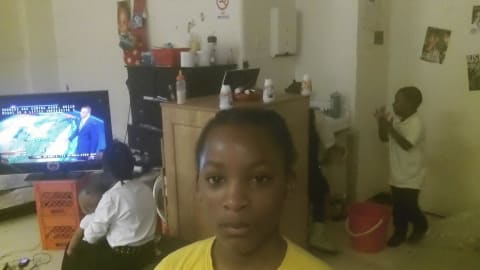Advertisement
A Story Of Resilience In New York City's Homelessness Crisis

One of the most important things that we've learned from the last year and a half is that there is a dire need for more education around the injustice and biases that occur within our country. If you are privileged enough to have avoided the physical and emotional hardships of inequality and prejudice directly, then it's likely that you don't fully understand what it's like to face racism and poverty in unequal America. There is always more to learn and more to be done.
Pulitzer Prize–winning journalist Andrea Elliott of the New York Times sheds light on the power of resilience, the importance of family, and the cost of inequality in her recent book, Invisible Child. Following eight years in the dramatic life of a girl whose indomitable spirit is tested by homelessness, poverty, and racism in our country, Invisible Child illuminates some of the most critical issues in contemporary America. The excerpt below provides a mere glimpse into the riveting and unforgettable story that puts a spotlight on the homelessness crisis that has exploded in New York City.
To read more, purchase your copy of Invisible Child here.

Invisible Child by Andrea Elliott
Dasani can count the white people she knows on four fingers: a court-appointed lawyer, a sidewalk preacher, an activist nun, and a computer science teacher. Adding to their ranks is the occasional social worker, beat cop, or city inspector.
White people divide into two categories: those who are paid to monitor Dasani's family, and those who are called to help. Sometimes the same people wear both hats. Rarely does the family trust them. They figure in Dasani's life because of the work they do. And on the afternoon of October 4, 2012, this small circle expands to include me, a staff writer at the New York Times.
I am standing in front of the Auburn shelter trying to talk to homeless mothers. For days, I've been looking for a way into this shelter, which is strictly off-limits to the public and the press. Conditions are said to be grim. A legendary local nun, Sister Georgianna Glose, had told me that a family of 10 is crammed into one room.
The mothers look me up and down. I'm wearing the worn jeans of any street reporter—which could also, it turns out, be the attire of a social worker or, even worse, a snitch. Everyone on the outside tries to fit in.
"You should talk to her," says one mother, gesturing at a large freckly woman who is walking like a drill sergeant, trailed by seven children.
Chanel stops in her tracks and looks at me, unblinking (a practiced power move, she later explains). I introduce myself, handing her my card. She can see that I'm not a snitch, she will later admit, because I'm wearing a floppy, ill-fitting wool hat and I keep dropping my pen. I'm far too conspicuous to be in the narcotics squad.
Soon we are meeting in nearby parks, my notebook filling with the story of Chanel's life. Yet for every few lines I scribble down, another voice interrupts—the spunky 11-year-old daughter by Chanel's side.
Again and again, Dasani steals my attention—doing cartwheels and backbends, reenacting her latest battle with Auburn's incorrigible mice. For all of her flair, Dasani is a careful listener. She absorbs the facts of my life as if holding her own recorder: that I am a 39-year-old mother of two little girls; that I work for the investigative team at the Times; that I take the 2 train from the Upper West Side, sipping green juice that makes Dasani stick out her tongue as if gagging.
Each revelation opens new lines of inquiry. She wants to know why I'm talking on the phone in Spanish (my mother is a Chilean immigrant). She wants to know my sign (Sagittarius) and my favorite musician (Prince). She wants to know how far I've traveled (I show her a magazine story I wrote from the slums of northern Morocco).
Dasani and Chanel have no reason to trust me. Eventually, Chanel will confess that if I weren't a mother, she would never have let me near her children. It also helps that I am not, in her words, "all white" because I am "Latin." My ethnicity delights Dasani, whose biological father is half-Dominican. But to Chanel, race matters more. I am, at best, a white Latina with a graduate degree, making me the beneficiary of a privilege that she will observe and dissect for years to come.
My only other saving grace is the digital pen I use to record sound, which Dasani calls my "spy pen." Indeed, her family wants me to spy on Auburn. For this, I need their help. The shelter is heavily guarded, which means I must report from the outside. So I ask them to document the condition of their room with video cameras provided by the Times. We also give Chanel a cellphone, to ensure solid communication, as Supreme always exhausts the minutes of his "Lifeline" phone (provided for free by the federal government).
Soon I am staring at footage of mice, roaches, and mold on the walls. Auburn's decay is no secret to city and state inspectors, who have cited Dasani's room for 13 violations—including lead paint—since her family moved in. Elected officials and city administrators have also known of the shelter's problems for years, hounded by Fort Greene SNAP, the local nonprofit run by Sister Georgianna.
When Auburn's staff members visit Room 449, they seem more eager to scold than to help. They focus on the family's transgressions, finding the room "chaotic" and insufficiently clean. They give scant attention to Auburn's own obvious lapses—the absence of dividers for privacy, the presence of vermin.
Lately, it is the family sink that Auburn fails to fix. All night long, it drips and drips, keeping Dasani awake. She knows that her mother has pleaded with the staff to repair it.
Finally, Dasani gets fed up. She crouches down to examine the pipe.
"Nobody thought about pushing it in and twisting it," she says. A few quick jerks and she triumphs. Her siblings squeal.
It goes unremarked that here, in a shelter with a $9 million budget, operated by an agency with more than a hundred times those funds, the plumbing has fallen to an 11-year-old girl.
